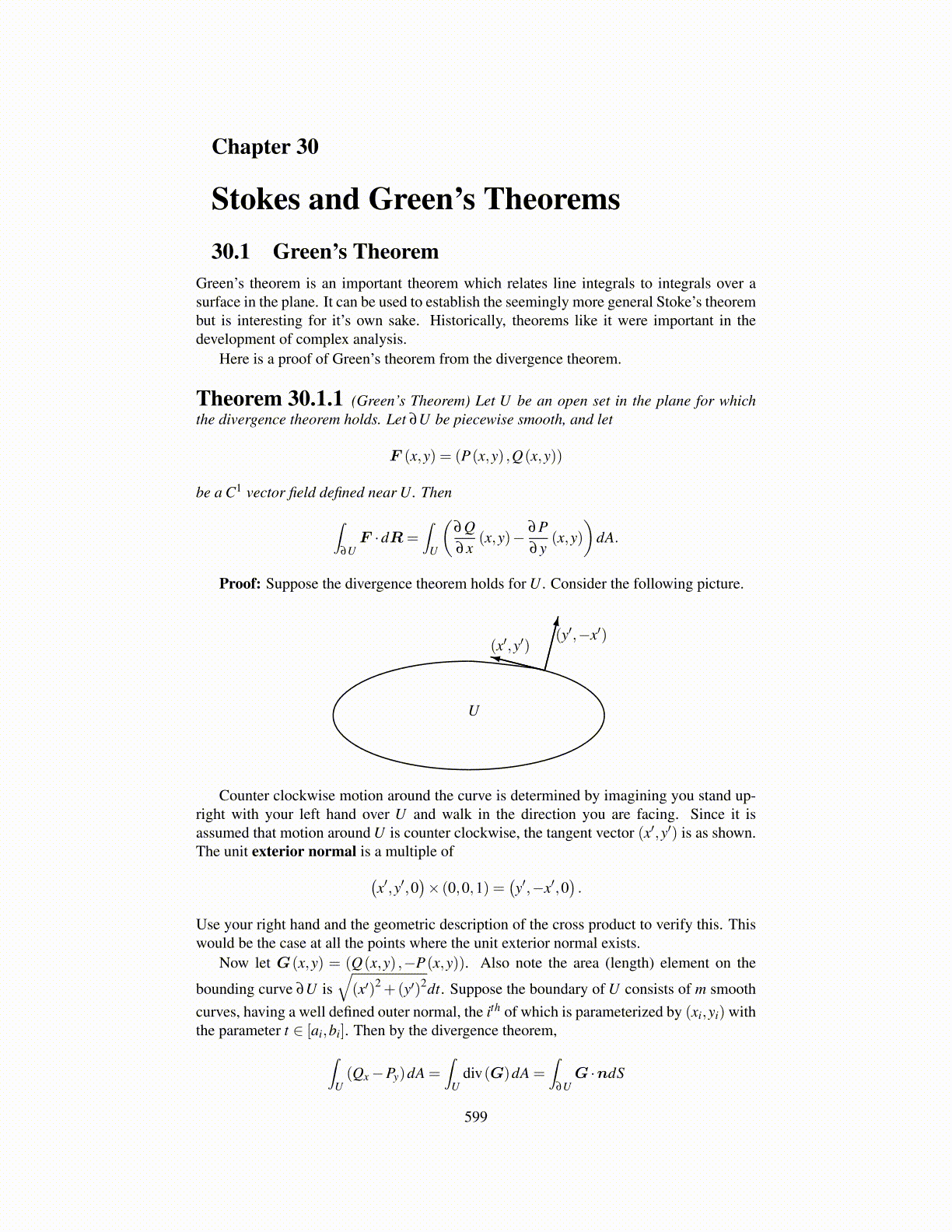
30.3. STOKE’S THEOREM FROM GREEN’S THEOREM 599
Recall the following definition of the curl of a vector field. Why do we even considerit?
Definition 30.3.1 Let F (x,y,z) = (F1 (x,y,z) ,F2 (x,y,z) ,F3 (x,y,z)) be a C1 vectorfield defined on an open set V in R3. Then
∇×F ≡
∣∣∣∣∣∣i j k∂
∂x∂
∂y∂
∂ zF1 F2 F3
∣∣∣∣∣∣≡(
∂F3
∂y− ∂F2
∂ z
)i+
(∂F1
∂ z− ∂F3
∂x
)j+
(∂F2
∂x− ∂F1
∂y
)k.
This is also called curl(F ) and written as indicated, ∇×F .
The following lemma gives the fundamental identity which will be used in the proof ofStoke’s theorem.
Lemma 30.3.2 Let R : U →V ⊆R3 where U is an open subset of R2 and V is an opensubset of R3. Suppose R is C2 and let F be a C1 vector field defined in V .
(Ru ×Rv) · (∇×F )(R(u,v)) = ((F ◦R)u ·Rv − (F ◦R)v ·Ru)(u,v) . (30.1)
Proof: Start with the left side and let xi = Ri (u,v) for short.
(Ru ×Rv) · (∇×F )(R(u,v)) = ε i jkx juxkvε irs∂Fs
∂xr= (δ jrδ ks −δ jsδ kr)x juxkv
∂Fs
∂xr
= x juxkv∂Fk
∂x j− x juxkv
∂Fj
∂xk=Rv ·
∂ (F ◦R)
∂u−Ru ·
∂ (F ◦R)
∂v
which proves 30.1.The proof of Stoke’s theorem given next follows [10]. First, it is convenient to give a
definition.
Definition 30.3.3 A vector valued function R : U ⊆ Rm → Rn is said to be inCk(U ,Rn
)if it is the restriction to U of a vector valued function which is defined on Rm
and is Ck. That is, this function has continuous partial derivatives up to order k.
Theorem 30.3.4 (Stoke’s Theorem) Let U be any region in R2 for which the con-clusion of Green’s theorem holds and let R∈C2
(U ,R3
)be a one to one function satisfying
|(Ru ×Rv)(u,v)| ̸= 0 for all (u,v) ∈U and let S denote the surface
S ≡ {R(u,v) : (u,v) ∈U} , ∂S ≡ {R(u,v) : (u,v) ∈ ∂U}
where the orientation on ∂S is consistent with the counter clockwise orientation on ∂U (Uis on the left as you walk around ∂U). Then for F a C1 vector field defined near S,∫
∂SF ·dR=
∫S
curl(F ) ·ndS
where n is the normal to S defined by
n≡ Ru ×Rv
|Ru ×Rv|.